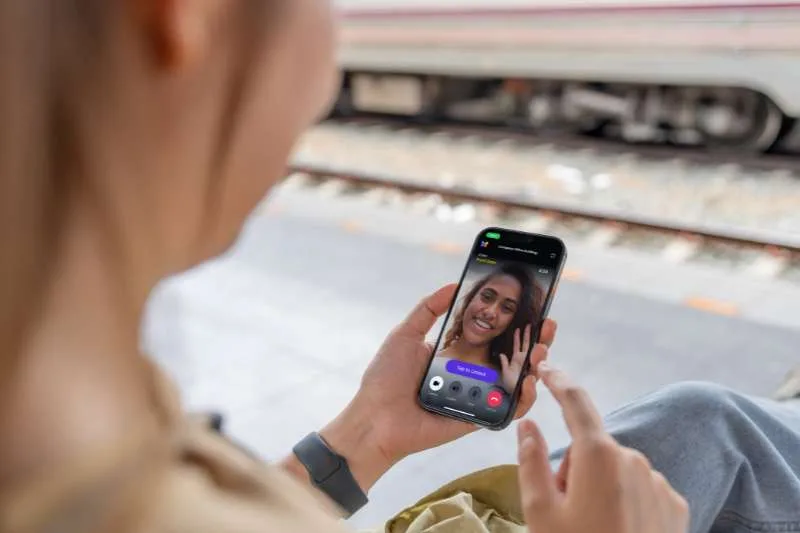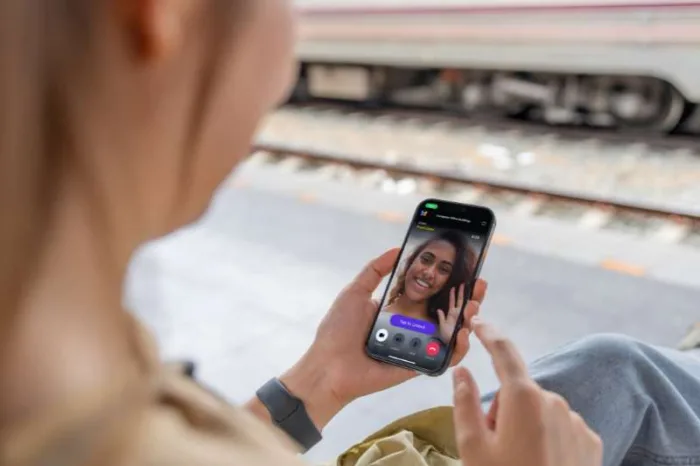Key takeaways
- Mobile access control replaces physical keys, cards, and fobs with secure digital credentials stored on a smartphone.
- Property managers can issue, update, or revoke access instantly through a cloud-based dashboard.
- Multiple credential types, including Bluetooth, NFC, and QR codes, make the system adaptable to different entry points and user needs.
- Strong security features like encryption, device-based authentication, and audit logs protect against unauthorized access.

Keys, fobs, and access cards are quickly becoming a thing of the past. Today, mobile access control is transforming how people enter buildings, gates, and secured areas from the convenience of their smartphones. By replacing physical credentials with secure, app-based mobile credentials, this technology streamlines entry for residents, employees, and visitors while giving property managers more control than ever before.
In this guide, we’ll break down what mobile access control is, how it works, and why it’s becoming a must-have for multifamily communities, gated developments, commercial buildings, and industrial facilities. You’ll also learn about the different types of mobile credentials, the security features that protect them, and how to choose the right system for your property.
This post covers:
- What is mobile access control?
- How does a mobile access control system work?
- Key benefits of mobile access control
- Types of mobile credentials
- Mobile access control vs. traditional access control
- Security features of mobile access control
- Use cases by industry
- How to choose the right mobile access control system
- Mobile access control FAQs
What is mobile access control?
Mobile access control is a security system that lets people use their smartphones as digital keys to unlock doors, gates, elevators, and other secured entry points. Instead of relying on physical keys, fobs, or cards, users store a mobile credential, a secure, encrypted pass, inside a mobile access control app on their phone.
This technology uses wireless communication methods like Bluetooth, NFC (Near Field Communication), or Wi-Fi to connect a smartphone to the access reader. When the credential is verified, the system grants entry instantly. Because everything is managed through the cloud, property managers can issue, update, or revoke credentials from anywhere without having to be on-site.
Mobile access control is increasingly popular in multifamily communities, gated developments, commercial offices, and industrial facilities because it offers a more convenient, secure, and scalable way to manage who can enter the property without the hassle of physical key management.
How does a mobile access control system work?
Mobile access control works by replacing physical keys, fobs, and cards with a secure digital credential stored on a smartphone. Instead of swiping or inserting something into a reader, users unlock doors, gates, and other entry points through a mobile access control app on their phone.
Here’s how it works in practice:
- Credential creation. A property manager or administrator uses the system’s dashboard to create a mobile credential for a resident, employee, or visitor.
- Credential delivery. The credential is sent directly to the user’s smartphone through a mobile access control app.
- Approaching the entry point. When the user arrives at a controlled door, gate, or elevator, the access reader detects the phone using Bluetooth, NFC, or Wi-Fi.
- Authentication. The system verifies the credential against its database to confirm the user’s permissions.
- Access granted. If approved, the reader signals the lock or gate operator to open. The event is recorded automatically in the system’s activity log.
Because most mobile access control systems are cloud-managed, permissions can be updated instantly from anywhere. This means managers can grant or revoke access in real time, monitor entry events across multiple locations, and integrate with other security solutions like video intercom systems for added visibility and convenience.
Check out ButterflyMX’s guide to access control:
Key benefits of mobile access control
Mobile access control offers a combination of convenience, security, and flexibility that traditional key or card systems can’t match. Here are the key benefits for property managers, residents, and installers.
For property managers and owners
- Centralized management. Control every door, gate, or elevator from a single cloud-based dashboard, even across multiple properties.
- Instant updates. Grant or revoke access in seconds without collecting physical keys or reprogramming fobs.
- Detailed audit trails. View time-stamped entry logs for security monitoring and compliance.
For residents and tenants
- Convenience. Unlock doors with a smartphone, no more worrying about lost keys or forgotten access cards.
- Guest access made easy. Share temporary mobile credentials or let visitors in remotely through an integrated video intercom system.
- Seamless experience. One app can manage access to multiple areas, from the front gate to amenities.
For installers and integrators
- Faster deployment. Less wiring and hardware compared to traditional systems means quicker installation.
- Remote maintenance. Many issues can be resolved off-site, reducing service calls.
- Opportunities for integration. Easily connect with complementary products like video intercoms, package rooms, and property management platforms.
Types of mobile credentials
Mobile credentials are the digital keys stored on a smartphone that allow users to unlock secured doors, gates, and other entry points. While all mobile credentials serve the same purpose, granting access without a physical key or card, they use different technologies to communicate with the access reader.
Here are the most common types:
- Bluetooth-based credentials
- NFC-based credentials
- Cloud-based QR codes
- App-based credentials with multi-factor authentication
Bluetooth-based credentials
These credentials use Bluetooth Low Energy (BLE) to connect a smartphone to the reader. They often work without requiring an internet connection, making them reliable even in areas with limited connectivity. Users typically tap a button in the mobile access control app or simply approach the reader to unlock.
NFC-based credentials
Near Field Communication (NFC) works like contactless payment, the user holds their phone close to the reader to authenticate. NFC is known for its quick response time and is compatible with many modern smartphones.
Cloud-based QR codes
Some systems generate secure QR codes that act as temporary or permanent credentials. These are ideal for visitors, contractors, or deliveries because they can be sent instantly via email or text and expire automatically after use.
App-based credentials with multi-factor authentication
For added security, some mobile access control systems require users to verify their identity with a PIN, fingerprint, or face ID before the credential is accepted. This approach helps protect against unauthorized access if a phone is lost or stolen.
The ButterflyMX Access Control System supports mobile credentials that integrate seamlessly with video intercoms, vehicle access controls, and other property entry points, giving residents, staff, and visitors a simple, secure way to enter.
Mobile access control vs. traditional access control
While both mobile and traditional access control systems are designed to manage who can enter a building or secured area, the way they operate, and the convenience they offer, are very different.
Traditional access control relies on physical keys, fobs, or cards. These methods are familiar and straightforward but come with limitations. Lost or stolen keys require rekeying locks, and misplaced cards or fobs must be replaced. Updating permissions often means physically reprogramming credentials on-site, which can be time-consuming and costly.
Mobile access control, on the other hand, replaces physical credentials with a secure digital key stored on a smartphone. Property managers can issue, update, or revoke these credentials instantly from a cloud-based dashboard, and users simply tap a button or present their phone near a reader to unlock doors or gates.
Let’s see how mobile and traditional access control compare:
For property managers, switching to mobile access control means lower operational costs, faster credential management, and a better experience for residents, employees, and visitors, all without compromising security.
Security features of mobile access control
Mobile access control combines convenience with strong security measures to protect properties, residents, and sensitive areas. By leveraging modern encryption, device authentication, and cloud management, it offers more protection than many traditional access methods.
- Encrypted credentials. Mobile credentials are encrypted and securely stored within the mobile access control app, making them difficult to clone or duplicate. This encryption protects data both in transit (between the phone and reader) and at rest (on the device).
- Device-based authentication. Each credential is tied to a specific smartphone, so even if someone gains access to the account details, they can’t use them on another device without authorization.
- Multi-factor authentication (MFA). Some systems require users to confirm their identity with a PIN, fingerprint, or face ID before a door will unlock, adding an extra layer of protection if the phone is lost or stolen.
- Cloud-based management. Because permissions are managed in the cloud, property managers can instantly revoke access if a credential is compromised. Updates are applied in real time, reducing the window of vulnerability.
- Comprehensive audit trails. Every entry event is automatically logged with details like date, time, and entry point. This makes it easy to review activity, investigate incidents, and comply with security regulations.
Use cases by industry
Mobile access control is adaptable to many property types, making it a valuable tool for improving security, convenience, and operational efficiency across sectors.
Multifamily communities
In apartment buildings and condominiums, mobile access control lets residents unlock the front door, amenity spaces, elevators, and even their unit using a smartphone. Property managers can grant or revoke access instantly and pair the system with a video intercom to manage visitors, deliveries, and service providers.
Gated communities
Residents can open vehicle gates and pedestrian entrances without stopping to swipe a card or enter a code. Temporary mobile credentials or QR codes make it easy to admit guests while maintaining a secure environment for the community.
Commercial offices
Employees use their phones to access the building, secure work areas, and meeting rooms. Managers can adjust access levels based on roles and schedules, and integrate with visitor management systems to streamline check-ins.
Industrial facilities
Mobile credentials and outdoor keypads help control and monitor contractor, vendor, and employee access to sensitive areas like warehouses, loading docks, and restricted production zones. Audit logs ensure compliance with safety and security regulations.
How to choose the right mobile access control system
Selecting the right mobile access control system means finding a solution that meets your property’s security requirements, integrates with your existing infrastructure, and offers a smooth experience for users.
Here are the key factors to consider:
Integration capabilities
Choose a system that works seamlessly with other security and property technologies you already use, such as video intercoms, vehicle access controls, elevator controls, and property management software. This ensures you can manage everything from one platform instead of juggling multiple systems.
Scalability
If you manage multiple buildings or plan to expand in the future, look for a cloud-based solution that can be rolled out across new properties without complicated rewiring or hardware overhauls.
User experience
The system should be easy for residents, tenants, employees, and guests to use. A well-designed mobile access control app with simple credential management will improve adoption and reduce support requests.
Security features
Look for encrypted mobile credentials, device-based authentication, multi-factor authentication options, and real-time access logs to protect against unauthorized entry.
Support and reliability
Work with a provider that offers responsive customer support, ongoing software updates, and a proven track record of system uptime. This is especially important for properties where secure access is critical 24/7.
Mobile access control FAQs
- What is mobile access control?
- How does an access control system work?
- How does mobile device security work with access control?
- How does user access control work?
- Can mobile access control work without an internet connection?
- Is mobile access control secure?
What is mobile access control?
Mobile access control is a security system that lets users unlock doors, gates, elevators, and other entry points with their smartphones instead of physical keys, fobs, or cards.
How does an access control system work?
An access control system verifies a user’s credential, whether mobile, card, or fob, against its database and grants or denies entry based on their permissions.
How does mobile device security work with access control?
Mobile credentials are encrypted and tied to a specific smartphone. Many systems also offer multi-factor authentication, requiring a PIN, fingerprint, or face ID before granting access.
How does user access control work?
User access control involves assigning specific entry permissions to individuals, managing those permissions, and tracking access events to maintain security and compliance.
Can mobile access control work without an internet connection?
Yes, systems using Bluetooth or NFC can authenticate credentials locally without internet, though some features like remote updates or live monitoring require connectivity.
Is mobile access control secure?
Yes. With encryption, device-based authentication, and real-time management, mobile access control can offer stronger protection than many traditional key or card systems.

Get your free quote!
Fill in the form below, and we'll email you right back.
Want a free quote?
Fill in the form below, and we'll email you right back.
You’ll be redirected shortly...





